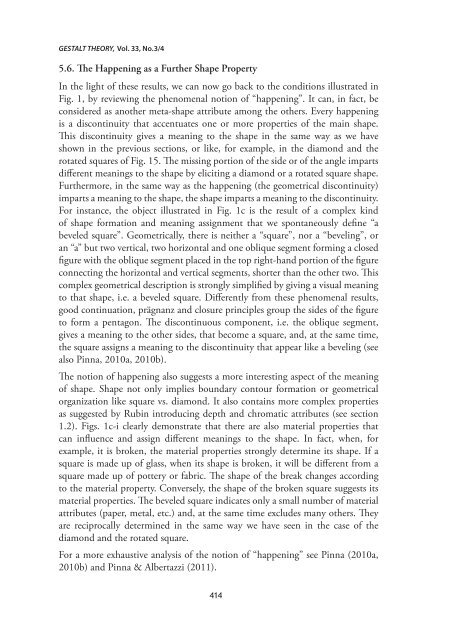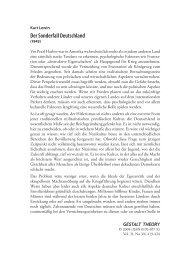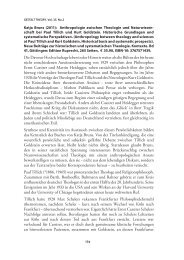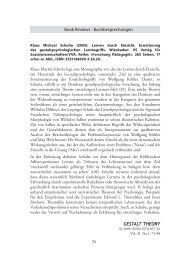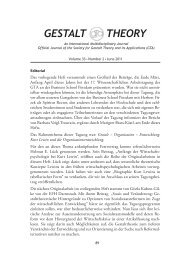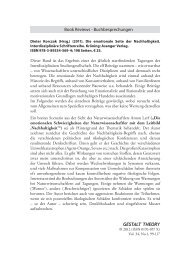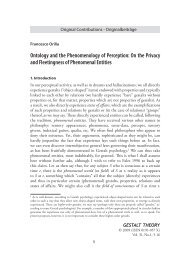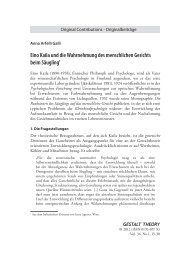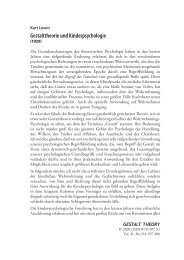What is the Meaning of Shape? - Gestalt Theory
What is the Meaning of Shape? - Gestalt Theory
What is the Meaning of Shape? - Gestalt Theory
Create successful ePaper yourself
Turn your PDF publications into a flip-book with our unique Google optimized e-Paper software.
GESTALT THEORY, Vol. 33, No.3/4<br />
5.6. The Happening as a Fur<strong>the</strong>r <strong>Shape</strong> Property<br />
In <strong>the</strong> light <strong>of</strong> <strong>the</strong>se results, we can now go back to <strong>the</strong> conditions illustrated in<br />
Fig. 1, by reviewing <strong>the</strong> phenomenal notion <strong>of</strong> “happening”. It can, in fact, be<br />
considered as ano<strong>the</strong>r meta-shape attribute among <strong>the</strong> o<strong>the</strong>rs. Every happening<br />
<strong>is</strong> a d<strong>is</strong>continuity that accentuates one or more properties <strong>of</strong> <strong>the</strong> main shape.<br />
Th<strong>is</strong> d<strong>is</strong>continuity gives a meaning to <strong>the</strong> shape in <strong>the</strong> same way as we have<br />
shown in <strong>the</strong> previous sections, or like, for example, in <strong>the</strong> diamond and <strong>the</strong><br />
rotated squares <strong>of</strong> Fig. 15. The m<strong>is</strong>sing portion <strong>of</strong> <strong>the</strong> side or <strong>of</strong> <strong>the</strong> angle imparts<br />
different meanings to <strong>the</strong> shape by eliciting a diamond or a rotated square shape.<br />
Fur<strong>the</strong>rmore, in <strong>the</strong> same way as <strong>the</strong> happening (<strong>the</strong> geometrical d<strong>is</strong>continuity)<br />
imparts a meaning to <strong>the</strong> shape, <strong>the</strong> shape imparts a meaning to <strong>the</strong> d<strong>is</strong>continuity.<br />
For instance, <strong>the</strong> object illustrated in Fig. 1c <strong>is</strong> <strong>the</strong> result <strong>of</strong> a complex kind<br />
<strong>of</strong> shape formation and meaning assignment that we spontaneously define “a<br />
beveled square”. Geometrically, <strong>the</strong>re <strong>is</strong> nei<strong>the</strong>r a “square”, nor a “beveling”, or<br />
an “a” but two vertical, two horizontal and one oblique segment forming a closed<br />
figure with <strong>the</strong> oblique segment placed in <strong>the</strong> top right-hand portion <strong>of</strong> <strong>the</strong> figure<br />
connecting <strong>the</strong> horizontal and vertical segments, shorter than <strong>the</strong> o<strong>the</strong>r two. Th<strong>is</strong><br />
complex geometrical description <strong>is</strong> strongly simplified by giving a v<strong>is</strong>ual meaning<br />
to that shape, i.e. a beveled square. Differently from <strong>the</strong>se phenomenal results,<br />
good continuation, prägnanz and closure principles group <strong>the</strong> sides <strong>of</strong> <strong>the</strong> figure<br />
to form a pentagon. The d<strong>is</strong>continuous component, i.e. <strong>the</strong> oblique segment,<br />
gives a meaning to <strong>the</strong> o<strong>the</strong>r sides, that become a square, and, at <strong>the</strong> same time,<br />
<strong>the</strong> square assigns a meaning to <strong>the</strong> d<strong>is</strong>continuity that appear like a beveling (see<br />
also Pinna, 2010a, 2010b).<br />
The notion <strong>of</strong> happening also suggests a more interesting aspect <strong>of</strong> <strong>the</strong> meaning<br />
<strong>of</strong> shape. <strong>Shape</strong> not only implies boundary contour formation or geometrical<br />
organization like square vs. diamond. It also contains more complex properties<br />
as suggested by Rubin introducing depth and chromatic attributes (see section<br />
1.2). Figs. 1c-i clearly demonstrate that <strong>the</strong>re are also material properties that<br />
can influence and assign different meanings to <strong>the</strong> shape. In fact, when, for<br />
example, it <strong>is</strong> broken, <strong>the</strong> material properties strongly determine its shape. If a<br />
square <strong>is</strong> made up <strong>of</strong> glass, when its shape <strong>is</strong> broken, it will be different from a<br />
square made up <strong>of</strong> pottery or fabric. The shape <strong>of</strong> <strong>the</strong> break changes according<br />
to <strong>the</strong> material property. Conversely, <strong>the</strong> shape <strong>of</strong> <strong>the</strong> broken square suggests its<br />
material properties. The beveled square indicates only a small number <strong>of</strong> material<br />
attributes (paper, metal, etc.) and, at <strong>the</strong> same time excludes many o<strong>the</strong>rs. They<br />
are reciprocally determined in <strong>the</strong> same way we have seen in <strong>the</strong> case <strong>of</strong> <strong>the</strong><br />
diamond and <strong>the</strong> rotated square.<br />
For a more exhaustive analys<strong>is</strong> <strong>of</strong> <strong>the</strong> notion <strong>of</strong> “happening” see Pinna (2010a,<br />
2010b) and Pinna & Albertazzi (2011).<br />
414


